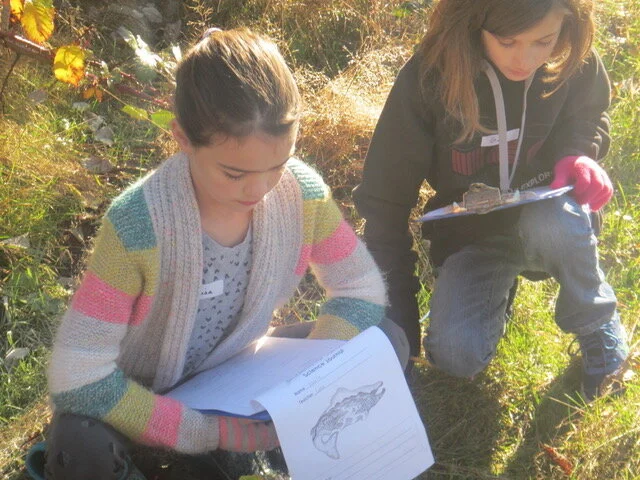Elementary Curriculum
Ages six through 12 years
Cosmic Education is at the center of the elementary curriculum. The teacher, or guide, presents Great and Key Lessons through the telling of stories and the presentation of beautifully illustrated timelines and charts. Students learn about the origins of all things, the beginnings of the universe, the formation of stars and planets, the progression of life, the rise of humans, and the advancement of civilizations. These stories and demonstrations form the basis of all the children’s explorations and serve as a launching ground for their studies. As students delve deep into these lessons, they gain sensitivity toward the universal and fundamental needs of humans, and the interdependence of all life on earth and on it’s resources.
Language and its origins serve as a foundation for many lessons in the elementary curriculum. Hands-on activities reinforce reading, writing, and oral expression and are important components of the language curriculum. The study of etymology (word origins), grammar and the function of words, and sentence analysis are fascinating to elementary students. The Montessori elementary activities in these areas allow students to experience their studies of words, not just read them from a textbook. Students in the elementary class love to use their language skills in writing poetry, doing research for special projects, writing plays and short stories, and keeping daily journals.
Mathematics and Geometry are also at the core of the elementary curriculum. Beginning with the story of the origins of our numerals, the elementary child is guided through the history of mathematics. The fascinating stories of those who, in the past, made the discoveries of the patterns of numbers, are an inspiration to the elementary-aged child. Students are not presented with lists of problems on a hand out. Instead they are led through an exploration parallel to that in which the mathematicians of the past followed. In this way the students make the discoveries themselves. The excitement of finding a formula or method of solving a problem (rather than just being told) inspires the student to practice and repeat their “discovery,” thus causing the discovered concept to be acquired and not just remembered for a short time and then forgotten. The mathematics materials are some of the most enjoyed by the elementary students.
Art and Music are integral to the elementary curriculum and provide the students with opportunities for self expression. Materials are made available for students to work with at any time during the work period and may include exploration in drawing, painting, clay work, paper making, weaving, printmaking, bookmaking, film, and photography, as well as, art appreciation and art history. Students explore various art techniques and create booklets, puppets, songs, dioramas, maps and other visual and artistic aids to embellish their research in other areas of the curriculum. Through the extensive Montessori music curriculum, the students are presented with music composition and music theory, performance, and music history. The students are provided with opportunities to sing and play rhythm instruments as well.
Cultural Studies and Sciences adds depth and vibrancy to the classroom. Students work extensively with maps, flags, and timelines to study the geography and history of the earth and its people. Students research the cause and effect of geological activity such as how mountains form, and why earthquakes occur. Students also explore the earth’s people and their cultures and how others meet their fundamental needs such as food and shelter. Physics, chemistry, zoology, botany, geology, biology, and ecology are among other areas of study. Students carry out detailed experiments and record their findings, learning the mechanics of machines, the processes of nature, and the laws of physics.
Physical Education includes both gross motor development, as well as spiritual and social growth. Students have the opportunities to engage in cooperative team play, fitness work, yoga, dance, and other movement practices, exercising physical, social, and emotional growth.
Going outs allow students to extend their research into the community and tap resources that may not be available in the classroom. Students are responsible for networking and planning their trips. A group of students learning about navigation may go on a sailing trip, students learning about the mechanics of radio may organize a trip to the American Museum of Radio and Electricity, or those learning about woodworking may go to visit a local craftsman in his studio.
A parent-volunteer or teacher accompanies a group of two to three students on an excursion.
Free the child’s potential, and you will transform him into the world. -Maria Montessori

